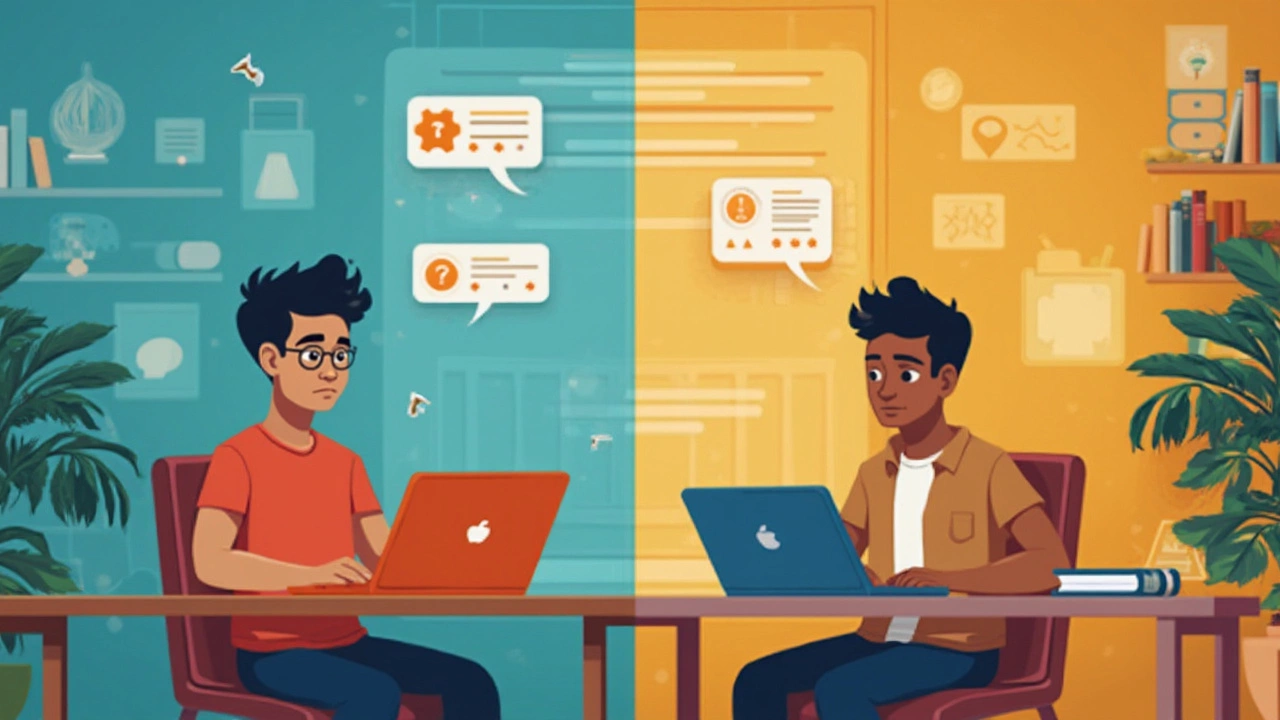Ever tried paying attention to a two-hour Zoom class and ended up scrolling social feeds instead? You’re not alone. The biggest struggle with e-learning isn’t lack of technology or boring teachers—it’s that it’s just too easy to check out mentally. People miss the buzz and focus of a real classroom, and it turns out that makes a huge difference.
Studies show that most online learners lose focus way faster than in-person students. In fact, researchers at Stanford and MIT found that online learners zone out or multitask so much, they actually remember less than their classroom buddies. Why? It’s the endless distractions—your phone, pop-up notifications, the temptation to open another tab.
So, what’s the secret to staying tuned in? For starters, look for e-learning platforms that break lessons into smaller chunks and keep you clicking, typing, or doing something every few minutes. Tiny quizzes, polls, and discussion boards help keep your brain from wandering. If you’re a student, try using a timer and setting short, regular breaks. Teachers can get creative—ask questions, encourage video responses, and mix up the routine. Small tweaks like these can keep both learners and teachers plugged in, not checked out.
- Too Easy to Tune Out: The Engagement Crisis
- Tech Barriers and Digital Divide
- The Lonely Side of Learning Online
- Quality Control: Not All Courses Are Equal
- Simple Fixes and Smart Workarounds
Too Easy to Tune Out: The Engagement Crisis
You know that feeling when you’re a few slides into an online class and suddenly realize you haven’t heard a word your instructor said? That’s the e-learning problem a lot of people run into—engagement just tanks. This isn’t just an opinion; The Journal of Online Learning and Teaching estimates that up to 60% of students get distracted by non-course-related websites during virtual lessons.
Why is this happening? Distractions are absolutely everywhere in the digital world. Switch to a new tab, check a notification, answer a quick message—it adds up. Unlike in a real classroom, nobody’s around to give you a look when you zone out. There’s less pressure to stay locked in, so our minds wander. And the thing is, multitasking sounds smart but is a myth. Neuroscience research out of Stanford actually confirms that people switching tasks online lose up to 40% of their productive time.
What about teachers? They have it tough, too. Trying to read faces in tiny video squares, or speaking to a bunch of blank icons, is no way to connect. No wonder it feels like some online learning challenges are built in from the start. When students don’t turn on cameras or answer questions, teachers don’t get real feedback, and classes drag. It’s rough on everyone.
| Activity | Average Attention Span (minutes) |
|---|---|
| In-person lecture | 10-18 |
| Online class | 6-8 |
| Uninterrupted reading | 20-25 |
So, what helps? The best e-learning platforms use interactive tricks to hold your attention. You might notice pop-up questions, breakout rooms, speedy 3-5 minute videos, or even silly emojis in chat boxes. Each of these makes you do something—watch, click, respond—and that helps keep you locked in. Here are a few easy things you can try yourself:
- Use a full-screen mode and put away your phone—out of sight, out of mind.
- Break your study time into 20-minute sessions with short breaks in between.
- Make a to-do list, and check off tasks as you finish lessons.
- If you’re teaching, call on students by name, or ask quick poll questions.
- Mix up formats: try audio, video, or discussion instead of just slides.
It’s not about fighting your brain but working with it. Once you know engagement drops fast during digital education, you can set up your own guardrails for better focus. Even tiny changes can make a big difference in how much you actually learn.
Tech Barriers and Digital Divide
Let’s get real—if you don’t have a good device or a steady internet connection, e-learning can be a struggle. Even now, about 15% of students in the U.S. say they sometimes can’t do their online assignments because of tech issues at home. And across the globe, the gap gets worse. In rural areas, many kids still share one device with family or rely on spotty cell signals.
The digital education divide isn’t just about having a laptop—sometimes the wi-fi is too slow for video calls, or software doesn’t run on that old computer. Even in tech-friendly households, figuring out which apps to use, or recovering lost passwords, eats up learning time.
| Tech Barrier | Impact (US 2024 Data) |
|---|---|
| No reliable device | 10% of students |
| Unstable or slow internet | 15% of students |
| Lack of tech help at home | 18% of students |
It hits teachers too. Many have to troubleshoot tech problems on top of trying to actually teach. And schools that can’t provide devices or affordable internet leave lots of kids behind—even as we call online classes the future of learning.
- If you’re stuck on slow internet, downloading materials for offline use and shutting down extra apps can help.
- Look for e-learning platforms that run well on mobile phones or low-end devices.
- Schools and libraries sometimes offer free device lending or internet hotspots—worth asking about if you’re struggling.
Solving the online learning challenges starts with making sure everyone can actually get online and stay there, without tech problems making things harder than they need to be.

The Lonely Side of Learning Online
Let’s be real: online learning can feel pretty isolating. When you’re stuck watching a lecture from your bedroom, you miss a lot more than you think—those hallway chats, group laughs, and quick “got a minute?” questions with friends or teachers. That sense of being in it together? It’s tough to get that on e-learning platforms.
One big study from the University of Michigan found that 53% of remote learners felt lonely or cut off at least once a week. That’s not just a bad mood—it actually messes with learning and memory. Humans are wired to learn with others. When you’re solo, it’s easy to shut down, lose motivation, and get behind.
What makes it worse? Most digital education tools are built for content—not for connection. You sign in, watch, click, log off. No real room for a laugh or a rant. Sure, some platforms offer discussion boards or chat, but let’s be honest—most people are hesitant to post, and threads are often a ghost town.
If you’re finding this tough, you’re not alone (really!). There are some simple tricks to fight the loneliness:
- Set up virtual study groups—even if it’s just you and one other classmate on a video call.
- Use chat apps outside of the e-learning platform to create more natural conversations. WhatsApp, Slack, or Discord are all solid choices.
- Reach out to your instructors for check-ins. Most teachers welcome questions or quick feedback sessions, even over email or video.
- Schedule breaks to physically move or just talk to someone—not everything has to happen behind a screen.
For schools and course designers, building in group projects and live sessions can help big time. Even adding a quick “icebreaker” at the start of live classes can break up the silence and make things feel friendlier.
| Feeling Lonely in E-Learning? | Reported by Students |
|---|---|
| At least once a week | 53% |
| Rarely | 19% |
| Never | 28% |
The bottom line? Online learning challenges go far beyond slow Wi-Fi. Be proactive for your own sanity, and if you’re an educator, don’t forget that students learn best when they don’t feel invisible.
Quality Control: Not All Courses Are Equal
Here’s something a lot of people don’t talk about: the quality of e-learning platforms is all over the place. Some courses are packed with real value—great videos, clear step-by-step guides, hands-on quizzes. Others just dump a few slides online and call it a day. There’s no universal quality check. Anyone can throw up a course, and that creates a wild difference in what you get as a student.
Take two math courses from different platforms. One might give you live tutorials, solid teacher feedback, and interactive problem solving. Another one? Maybe just a PDF and a list of links. A 2023 survey by Digital Learning Pulse found that 48% of online learners felt parts of their course were outdated or unclear. That’s nearly half the people paying for these programs!
So, how do you know you’re getting a solid class and not just a bunch of copy-pasted content? Here’s where you need to check:
- Look for accreditation. Legit e-learning courses are often partnered with trusted schools or organizations. If you can’t find any proof a course is vetted, you might want to look elsewhere.
- Check reviews and ratings. Honest feedback from past students is like gold. If a course keeps getting slammed for being confusing or light on substance, believe it.
- Preview material. Many platforms let you watch a sample lesson. If the sample is low effort, the rest probably won’t get better.
- Compare instructors. Teachers matter. Make sure the instructors actually have experience or credentials in the topic, not just a nice profile picture.
Some platforms, like Coursera and edX, have quality checks built in, but plenty don’t. The difference can be night and day. If you see a money-back guarantee or a clear learning path with checkpoints and certificates, that’s a good sign the course is serious about teaching—not just cashing in.
| E-Learning Platform | Average Course Rating (out of 5) | Completion Rate (%) |
|---|---|---|
| Coursera | 4.6 | 59 |
| Udemy | 4.2 | 32 |
| edX | 4.5 | 56 |
Quality can make or break your learning experience. Don’t settle for less—make sure your online course is worth your time and money.

Simple Fixes and Smart Workarounds
Tackling the biggest problems in e-learning platforms isn’t about finding some magic formula—it’s about making a bunch of small, practical tweaks that really add up. Let’s cut right to what actually works, according to real research and everyday experience.
First, lots of experts push for shorter lessons. Instead of one giant 90-minute video, break content into 10-15 minute segments. Not only do learners stay awake, but they actually remember more. According to a study by the Online Learning Consortium, courses using microlearning (bite-sized lessons) saw a 20% jump in completion rates compared to traditional long videos.
It’s also smart to keep students active. Quizzes, quick polls, and instant feedback keep people busy and prevent passive scrolling. Here’s a simple checklist you can try for any online class:
- Start each lesson with a question to get folks thinking.
- Break up topics with polls or mini-quizzes every 10 minutes.
- Use discussion boards or group chats for peer-to-peer talk.
- Mix in real-life examples—don’t just stick to theory.
- Encourage cameras on if possible, but give everyone the option.
But what about tech headaches or uneven internet? Provide downloadable notes, offer audio-only options, and make sure assignments can be done offline. A lot of e-learning problems come down to simple accessibility tweaks.
Another trick is to set a predictable routine. Post clear weekly plans, so no one’s left guessing what comes next. In a recent Coursera report, students who had regular schedules said they were less likely to fall behind.
Here’s a quick comparison based on what works for engaging online learners:
| Strategy | Impact |
|---|---|
| Microlearning lessons | +20% course completion |
| Active quizzes & polls | Higher retention, less multitasking |
| Weekly schedules | Lower dropout rates |
| Peer chat & discussion | Improved motivation |
Making the tech less intimidating is a must. Platforms like Khan Academy and EdX offer user-friendly dashboards that don’t require a computer science degree to use. It helps to pick tools that work across devices, especially since over 50% of online learners access classes on their phones.
On keeping it human,
“The key to successful online learning is not the technology, but how you use it to foster connection and motivation,” says Dr. Barbara Oakley, co-instructor of one of the world’s largest online courses, Learning How to Learn.So, even in digital spaces, real conversation matters most.
The bottom line? Don’t overthink it. Fixing the big problems with online learning challenges is about a bunch of these little wins. They’re not hard to do, but they make all the difference when you actually use them.
